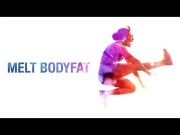
People aiming for weight loss and accelerated fat burning, are often asked to aim for the ideal heart rate, to burn fat during exercise. In this article, I explain how to calculate this rate.
Weight loss is all about losing the excess baggage we carry around, through regular exercise, designed to achieve an optimal heart rate, to burn a maximum amount of calories in general. The information provided here is based on online research and opinions of fitness experts. For detailed information, you are advised to consult a qualified doctor.
The Ideal Rate
The rate at which we burn fats and calories in general, is dependent on the heart rate achieved during exercise. The rate achieved, is in turn, directly proportional to the degree of intensity achieved during exercise. In general, the body never utilizes one exclusive source of energy. It derives energy from the simultaneous burning of fats and carbohydrates.
However, at a given point of time, the percentage of fats burnt, depends on the heart rate, the carbohydrate reserves of the body, and basically the overall energy requirement. It has been observed that during low-intensity workouts, the degree of fats burnt, is slightly more than carbohydrates.
As the intensity increases, more of carbohydrates are used, as they can be burned faster. At higher rates, however, again fat reserves are used more. Of course, there is no absolute range at which more fats are burnt as it varies from person to person. That is because the metabolic rate of each person is different. Medical research has revealed that the ideal burning rate would be in the range of 65% to 85% of the maximum.
However, for weight loss, what matters is how many calories you use up during exercise everyday. Be it a high-intensity exercise in a short time or low-intensity exercise for a longer time, as long as you are burning a sizable amount of calories every day, your weight loss program will be on track.
For people who cannot exercise at high intensity due to age or health reasons, a low-intensity exercise for longer duration, at a medium heart rate can be effective. Those who can, should aim for a high-intensity exercise as it contributes to greater burning of calories.
Calculating the Rate
There is an established formula called the modified Karvonen formula, devised for this purpose.
First step is to calculate your specific age predicted maximum heart rate (MHM). To do that, multiply your age in years by 0.67 and subtract it from the number 206.9. The number that you get is your maximum heart rate. Like for me, my age being 24, the maximum heart rate is [206.9 – (24 x 0.67)] = 190.82.
Next step is to calculate your resting heart rate (RHR). To do that, count your pulse for a minute after waking up or after you are sufficiently relaxed. Then subtract the RHR from the MHR. For example, my RHR is 57. So I must subtract 57 from the MHR, that is 190.82 – 57 = 133.82.
Now, we can calculate the maximum and minimum of the fat burning zone. It is 65% to 85% of the difference between MHR and RHR. That is, in my case, the range would extend from (65% x 133.82) to (80% x 133.82) that is from 86.98 to 107.056. Adding my RHR to both these high-end and low-end limits of the target rate to burn fat, will give me the range.
Therefore, in my case, the range to burn fat optimally, would be (86.98 + 57) to (107.056 + 57), that is from 143.98 to 164.056. Rounding up the numbers, that gives me a target heart range to burn fat from 144 to 164.
The main thing to understand is that regular and consistent exercise will lead to a faster weight loss. The percentage of weight loss is directly proportional to the effort you put into it, on a daily basis.
Staying in the fat burning zone of the heart rate range, through low-intensity and long workouts, will enable you to burn fat more efficiently and rapidly. However, you could also aim for a high-intensity workout, which also leads to the same output, in a shorter period of time. To design an exercise routine, that is customized to achieve your weight loss target, taking your physical capacity into consideration, consult a qualified fitness trainer.







































